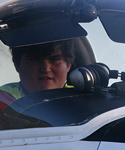That last point is a good reason why good communication is required. I suppose the glider banking to the right and tug to the left on release is a further reason? Even if the tug doesn't notice, then atleast the glider can get out of the way hopefully.
I presume in the brief they agree a release height or some such indication just to help reduce the possible chances of collision or other accidents. Well, and they have a radio to use too.
No doubt these guys use radio comms a lot because they're putting on a show, but our club has to avoid clogging the CTAF, so we keep it "old school": a prior agreement to release at a certain height (along with a rough outline for the tow, i.e. in the case of a student working on "boxing the wake"), the hand signals... but the handheld in the glider is rarely used, except when flying the pattern.









